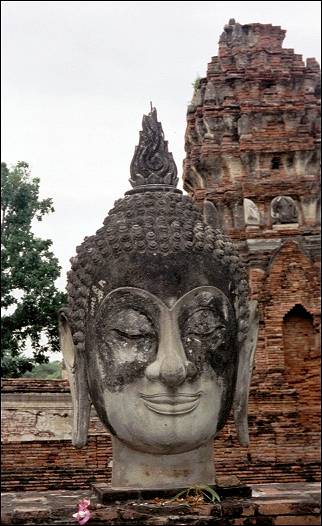
|
Green Thailand
We slither
through the jungle
on rocky paths
The Royal Palace in Bangkok is all pomp and circumstance. Boat trips on the canals take you along wooden houses and a floating market. In Ayuthaya and Chiang Mai are remains of impressive temples. On a jungle trek we slither along chasms, waterfalls and mountain villages. Karaoke ships sail near the Bridge on the river Kwai. You can spend the night in a floating bamboo hut or in a treehouse in Khao Sok National Park. And finally we relax on the peninsula of Phuket.
Travelogue & photos: Johan Siegers
Our first impression of Bangkok is overwhelming. The heat, the humidity, the amount and stench of traffic. But there also are stalls where you can buy food. It is supposed to be safe to eat streetfood here, but most of it looks undefinable and doesn't appeal to me, certainly not on my first day.
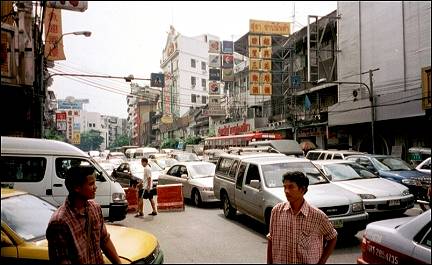
|
In Chinatown the streets are organised by craft: each one has a different group of workshops, which all look like garage boxes. In one of the streets everyone seems to be recycling old metals.
Old cars are taken apart and their parts are sorted by type. The working conditions are apparently not a subject of concern. Angle grinders are used without any protection for the eyes. Specializing is the big thing here: there are stores that only sell ladders. There are streets where the only merchandise is gold jewelry.
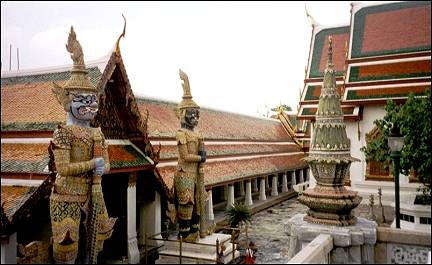
|
We take a taxi to the Royal Palace. Taxis are not expensive in Thailand. They all have taxi meters, but you have to make sure the driver turns it on. If you don't, you'll have to negotiate about the price after the ride.
Because of a misunderstanding the taxi driver drops us at the National Museum. Fortunately we see the towers of the palace stick out above the trees. While we walk to the palace, a few drops of water fall from the sky. Not even half a minute later we have to seek shelter because of a torrential downpour, our first experience with the last remains of the wet monsoon.
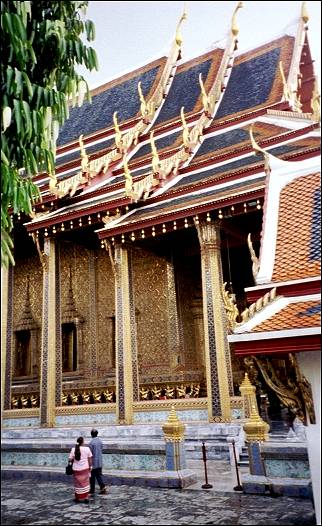
|
The palace is an example of Thai pomp and circumstance. Lots of gold and decorations. It strikes me as somewhat kitschy. Like everywhere else, there are many Buddha statues in the palace.
According to the dress code for the palace, our knees have to be covered. The palace guard does not approve of our shorts. Fortunately there are free baggy pants and skirts on loan.
Before we enter the palace, we have to take off our shoes. We also have to make sure we never point our foot soles toward Buddha. This is considered an extreme insult in Thailand.
The Chedi (looks like an upside down ice-cream cone) supposedly conatains a fragment of Buddha's breastbone.
On Bangkok's canals
You can bathe in them, do your laundry and your dishes
In the afternoon we take a water taxi to a market. We sample several fruits that are less known where we come from: rambutan and durian, which stinks but has a subtle taste.
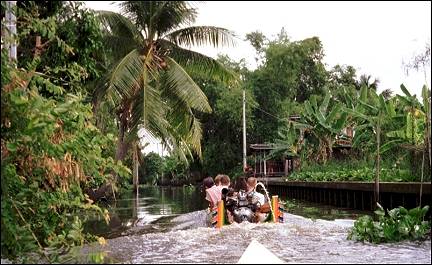
|
Then we take a tour of the klongs (canals) in a longtail boat. It owes its name to the fact that its propeller sticks out in the water because it's attached to a long axis.
These propellers are easily lifted out of the water to avoid waterplants and other stuff. The boats are fast, which makes the tour spectacular.
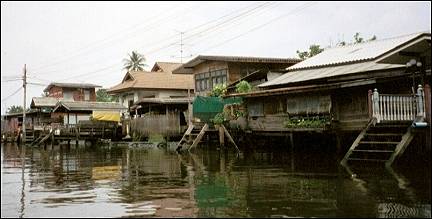
|
We see a completely different part of Bangkok. There is a lot of green along the klongs. We notice for the first time that we really are in a tropical climate. Many houses along the water are made of bamboo.
The unpainted wood looks shabby, but the large satellite disks on and by some houses make us think that the people who live here may not be very poor at all. People who live along the klongs use them fully. They bathe in the water, and do their laundry and their dishes in it.
Wats (temples) stand between the houses. Temples are important as symbols of worshipping. Some temples are financed by the people, others by the king.
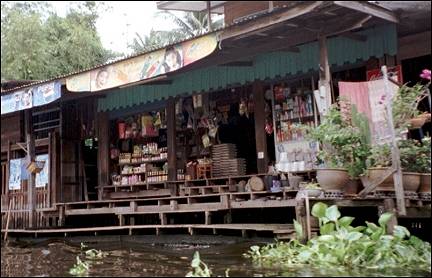
|
Temples built by the people are public. They can be recognized by the small temples that surround the main one. If one stone lies in front of the temple, it is built by the people; if there are two stones, the temple is built by the king.
Back in Bangkok we want to see the lying Buddha, but that isn't possible because it's Sunday. Instead we visit the Golden Mount (Wat Srakes). This temple was built on a mountain top and can be reached by a long staircase. Inside the Thai worshippers burn incense.
Ayuthaya
Once the mighty capital of ancient Siam
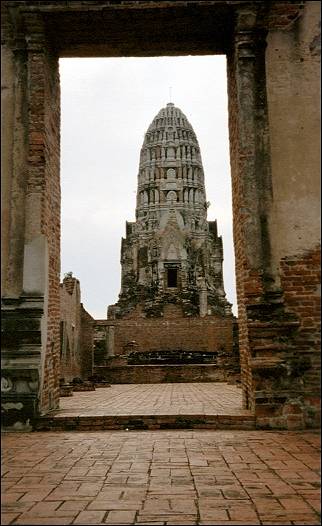
|
The next morning we take the train (third class) to Ayuthaya. The "airconditioning" consist of open windows and ceiling fans.
When we eat liquorice, some children look at us longingly. It turns out they like English liquorice, but our double-salty ones are not popular.
On the way rice paddies and palm trees appear in view.
Once upon a time Ayuthaya was the mighty capital of ancient Siam. There still are large, impressive ruins of temples, two of which we visit.
We also take a trip with a longtail boat on the river. Half way we are surprised by a tropical rain- and thunderstorm.
When the rain finally stops, we already have to go back, because we have to catch the night train to Chiang Mai.
Chiang Mai
It looks as if the top of the dome has collapsed
We take a walk in Chiang Mai and are approached by a taxi driver who wants to show us some highlights for a low fee. First we visit a partly dilapidated temple, the name of which I don't remember. It looks as if the top of the dome has collapsed, while the rest of the structure is still intact.
Our next stop is at a snake farm. I have rarely seen such bad animal accomodations. Snakes who don't have any water to cool themselves in this hot weather, a cage with two kinds of geckoes, one of which is so frustrated finding a way out that it has injured its mouth with the wire mesh, the other one misses a leg. A monkey in a diminutive cage. A snake who is stuck between the mesh and a bar, and who is being eaten alive by ants.
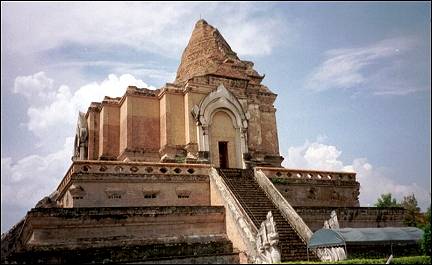
|
The rest of the taxi tour is also commercially oriented. We visit a workshop where umbrellas are made by hand and of course there is a shop where you can buy them.
The next visit is to a silk factory. We see how the larvae are killed in hot water and how the silk is spun into threads. A little farther six ladies with looms are hand-weaving silk fabrics.
The next stop is a diamond polishing/silversmith workshop, with a large and posh store. We want to leave the store as soon as possible, but a tropical rain shower makes us decide to browse the display cases anyway.
When we make it clear to the taxi driver that we have seen enough shops, the system behind this tour becomes clear. Taxi drivers are paid commission for every group they bring in.
Trekking
The red soil is wet and slippery because of the rain
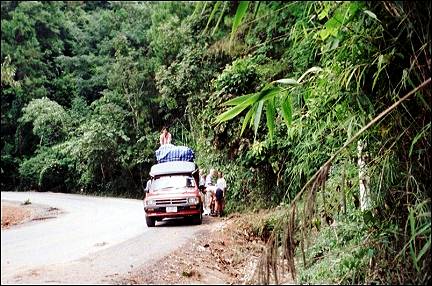
|
The next morning we are taken to the starting point of our four-day trek in a sun tau (a pick-up truck with benches on the platform, which is covered).
The hike begins in a mountainous area, and the first leg is of course up. The red soil is still wet and slippery because of the rain. After half an hour of hiking it starts to rain. When it becomes clear that this shower could last for a while, we don our rainwear. The shower slowly becomes a downpour.
After a two-hour walk we arrive in the village where we will spend the night. The village people belong to the Karen tribe. In predominantly Buddhist Thailand they are a Christian minority. The houses are simple. They are made of bamboo and almost all of them stand on stilts. Underneath the houses roam chickens and pigs, the latter tied to ropes.
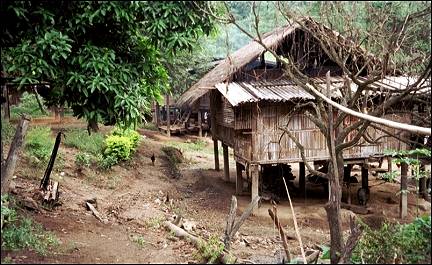
|
Our Thai guide cooks dinner for us. Meanwhile, we hang up our mosquito nets and roll out our sleeping bags. When I take off my shoes, I see that a leech has attached itself to my leg.
I get the advice to use a tree leaf to pull off the leech, not with my bare hands, because it will immediately seek a new host. The tree leaves are way too smooth to pull a small worm from your leg, but I succeed with tick tweezers.
During our hike the next day it also rains. Now I understand why traveling in the rainy season is harder. The soil is a kind of clay, which gets slippery in the rain. And so I slip and fall a few times. But what I hate more is that the paths are sometimes narrow and rocky. Next to the hiking trail there are often deep chasms. We have to pay so much attention to where we put our feet, that we don't have time to enjoy the beautiful surroundings.
Halfway our hike we arrive at a beautiful waterfall. Some of my traveling companions cannot control themselves and take a dive in the clear water. The guide has brought rice with vegetables and chicken, neatly wrapped in banana leaves.
After our meal we still have a two-hour hike ahead of us. Because we are almost constantly going up the mountain, it gets really hard. We all wear anti-leech socks now. These are tightly woven socks which are worn over your regular ones and over your pants. They reach almost up to your knees. They prevent leeches from attaching themselves to your leg.
We were told that it's important to walk at your own pace. Guides walk up front and at the back. If you arrive at a fork and don't know which path to take, don't guess, but wait for the guide who always walks in the rear.
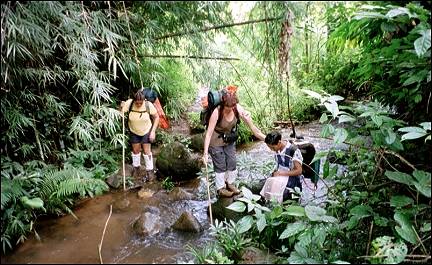
|
And that is what we do. We are at a fork, and the group who walked ahead of us is nowhere in sight, so we have to wait for the others. After waiting for half an hour we still don't see anyone and begin to have doubts.
A long way back, in a rice field, we already had to choose, but at that moment it seemed clear which one was the right path... We deliberate what would be wiser: walk on or return to the last village we passed, when one of the porters appears: we are on the right path.
A little before the next village we see a heap of clothes in a bamboo basket, in the middle of the jungle. It turns out that the clothes belong to someone who is seriously ill. The villagers sacrifice the sick person's cloths to the mountain god, hoping to win favor with him, so the sick person gets better.
The second village looks a little wealthier than the first one. According to western standards the houses still look shabby, but the village youth rides around on mopeds.
Here we have to decide whether to continue on our trek, which includes a day-long descent, followed by an elephant ride and rafting on bamboo rafts, or return to Chiang Mai.
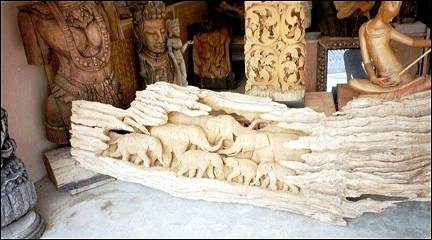
|
As appealing as the elephants and the rafting sound, the thought of a long descent on the slipery, rocky soil is unattractive enough to decide to go back to Chiang Mai.
We are taken back to Chiang Mai in the back of a pick-up truck. When we just arrived in Thailand, we were amazed that the Thai are transported this way and now we experience it ourselves. In the morning it can be cold on an open platform. A few villagers who travel with us wear thick coats and balaclavas. We are in T-shirts and shorts.
Back in Chiang Mai we take our clothes to the laundrette. This is perfect when you are traveling. I am surprised that they succeed in removing all dirt from our clothes.
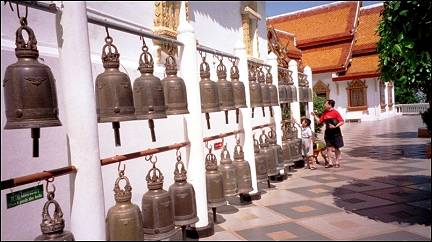
|
The next day we take a local bus to a Han Dong, a village that specializes in wood carving. There is much rubbish for tourists in the shops, but we also see some wonderful examples of sophisticated wood carving.
We visit Doi Suthep, a densely wooded mountain with a beautiful temple (Wat Doi Suthep) at an altitude of 1,600 meters. You can take a cable car or stairs with 304 steps to get there. In a large part of the complex, you can hear the temple bells being sounded by visitors. A recently installed man-sized bell is the target of playing children. From the edge of the temple complex we have a great view of the surroundings.
Floating market in Bangkok
On the quays it's one souvenir vendor after another
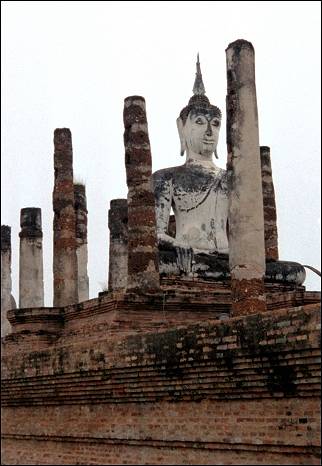
|
We rent bicycles in the historical park Sukothai and ride around in the huge park. The temples here were built in Khmer style. They remind me a little of the ruins at Ayuthaya.
When we have seen the two main complexes, it begins to rain a little. In a covered area by a food stall we have a tasty, spicy noodle soup. Fortunately the rain stops, so we can rest a little on a meadow. We are getting tired of temples.
Late in the afternoon we take the night train back to Bangkok, where we visit the floating market the next morning. Originally this was a market for the local population: a place for trade. Now it's become more of a tourist attraction.
There is still trade going on on the small boats, but a large part of the merchandise is clearly meant for tourists. Along the quays it also is one souvenir vendor after another. But it's still fun to watch a bowl of noodle soup being prepared in a small boat.
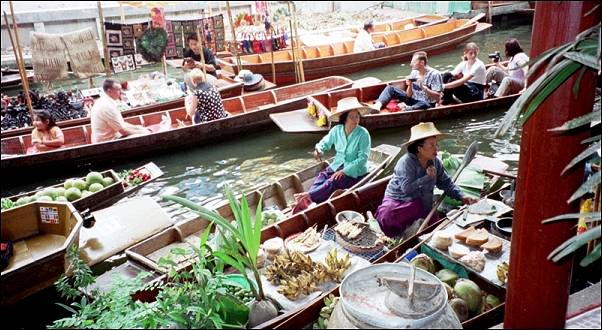
Just as in other places we visited, we are accosted by Thai who want to sell us small jars of tigerbalm. We don't understand why. Are tourists complaining all the time about muscle aches because they walk so much? Only much later we hear from a Thai guide that tigerbalm also is soothing for mosquito bites and even though malaria supposedly isn't found here anymore, there still are zounds of mosquitos.
Bridge on the River Kwai
There are floating karaoke shows on the river
In the afternoon we visit Erewan Falls National Park. Its waterfalls lie in a green jungle and have seven terraces from which the water falls. The rain messes with our plans this time also. After the fourth terrace the path becomes so bad that I give up.
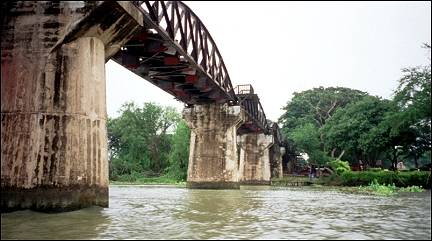
|
We spend the night in a houseboat on the river Kwai. There are floating karaoke shows on the river.
We take an excursion in a longtail boat to the bridge on the river Kwai (the iron one) and to the large cemetary where the war victims rest who died building the bridge.
The next day we take a train ride on a part of the infamous Birma railway. 30,000 prisoners of war from England, Australia and The Netherlands, and another 100,000 from India, Singapore, Birma and Thailand worked on the construction of this railway-of-death. Over half of both groups died from starvation, tropical diseases, the hard labor and mistreatment by the Japanese army (information: JEATH museum).
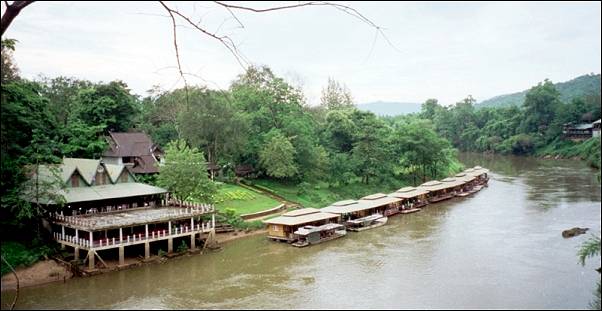
The train doesn't cross the bridge. It is now pedestrian territory. We also take a short walk on the bridge. It isn't the original one that was built by the POWs. It was an important point in the trajectory of the Birma railway and was therefore often bombed. The wooden bridge was, still during the second world war, replaced with an iron one. This bridge is still in place.
You have to watch where you're going on the bridge. There is a footpath at the center, but on the sides are holes through which you easily could fall. A dangerous situation like this would be unthinkable in Europe.
Nakhon Pathom
It really is a humongous landmark
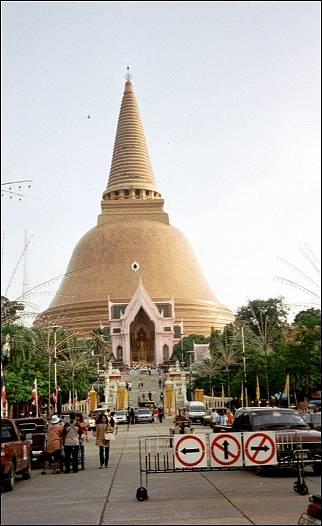
|
In the afternoon we take a local bus to Nakhon Pathom, which has the largest chedi of Thailand. It really is a humongous landmark. I buy an amulet that has been blesed by a living Buddha.
They are monks who have reached a level of enlightenment that enables them to break the cirkel of birth, death and rebirth, but who have decided not to go up into Nirvana, but to stay on earth to help us. Almost every Thai has an amulet like this.
We visit a market that is clearly local. There probably aren't many tourists who are inclined to buy insects like large beetles or larvae to eat.
Khao Sok National Park
Near our floating vacation park a monkey eats a banana
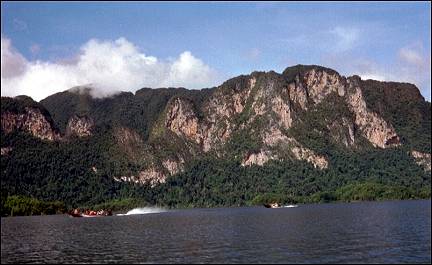
|
National Park Khao Sok is one of the most beautiful parks in Thailand, with a 739 square kilometers surface. We are sailing in longtail boats on the reservoir where we will spend the next two days.
The weather is exceptionally good and the views of the greenery and rock formations is fantastic. We spend the night in small bamboo huts that float on the lake. It's primitive, but very beautiful.
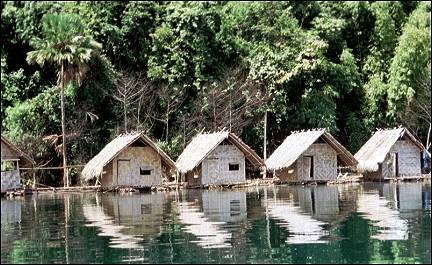
|
The bathroom is on the shore and can only be reached via a narrow path made of bamboo sticks tied together. In the daytime that is not a problem, but in the dark it's not something you would do for fun.
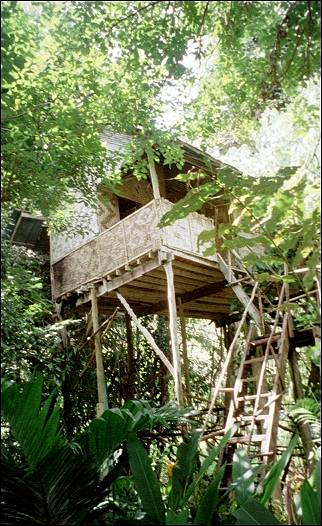
|
The water in the reservoir is clean and has a wonderful temperature. I swim a little, lie in the sun, and of course get burned.
In the evening we go by boat to look for wild monkeys. Unfortunately we only hear some rustling in the bushes.
The next day we are luckier. Near our floating vacation park sits a monkey on the shore eating a banana.
After two days we are brought to a different part of the National Park. Here we spend the night in a treehouse. The bamboo hut is at least as primitive as the one on the lake and at least as much fun.
I never knew how noisy the jungle is at night. All kinds of crickets and other animals make loud noises.
Phuket
It's wonderful to ride through the Thai countryside
Phuket is a peninsula and our village is by the sea. Some people go diving or snorkling. Because the weather isn't good for the beach, I rent a moped, which is inexpensive. But they don't give insurance. Just when I am about to protest, our hostess - who is also renting a moped - says that it's okay. It apparently is a common practice.
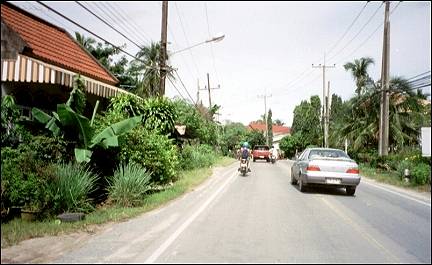
|
It's wonderful to ride through the Thai countryside. We take secondary roads that wind through the mountains. You can smell the earth, the plants and the food that the Thai are cooking.
The mopeds are very good. Without any problem they go up to 90 k/p/h. Mopeds should stay on the left side of the road (traffic keeps to the left in Thailand), but as a former motor-biker I keep almost automatically riding in the middle of the lane. The fact that the cars usually don't drive faster than we do, also contributes to this.
We arrive at a stall made of corrugated iron, in a spot with a very beautiful view. We want to eat. We try to explain that we want noodle soup, but the woman doesn't speak English. She invites us to follow her into the "kitchen", where she opens a coolbox with pieces of chicken, shrimp and fish. We can point at something and she will prepare it for us. But because she doesn't have noodles, we decide to continue on.
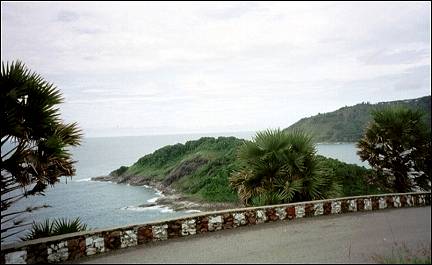
|
When we coincidentally arrive at Phromthem Cape, it turns out that this is the highest cliff in Thailand. We have a great view of the sea here.
There also is a Buddha statue, surrounded by a few hundred stone elephants, varying from 5 to 20 centimeters in height. Where we come from, they would have been stolen by now.
The next day the weather is better and I decide to go to the beach. The sea water is clear, wonderfully warm and remains shallow for a long distance. It's great to swim here or just float. Back on the beach, I play with a stray dog who is tame enough for me to pick him up and carry him into the sea.
On the way back I buy a small bottle of Thai whiskey in the airport.